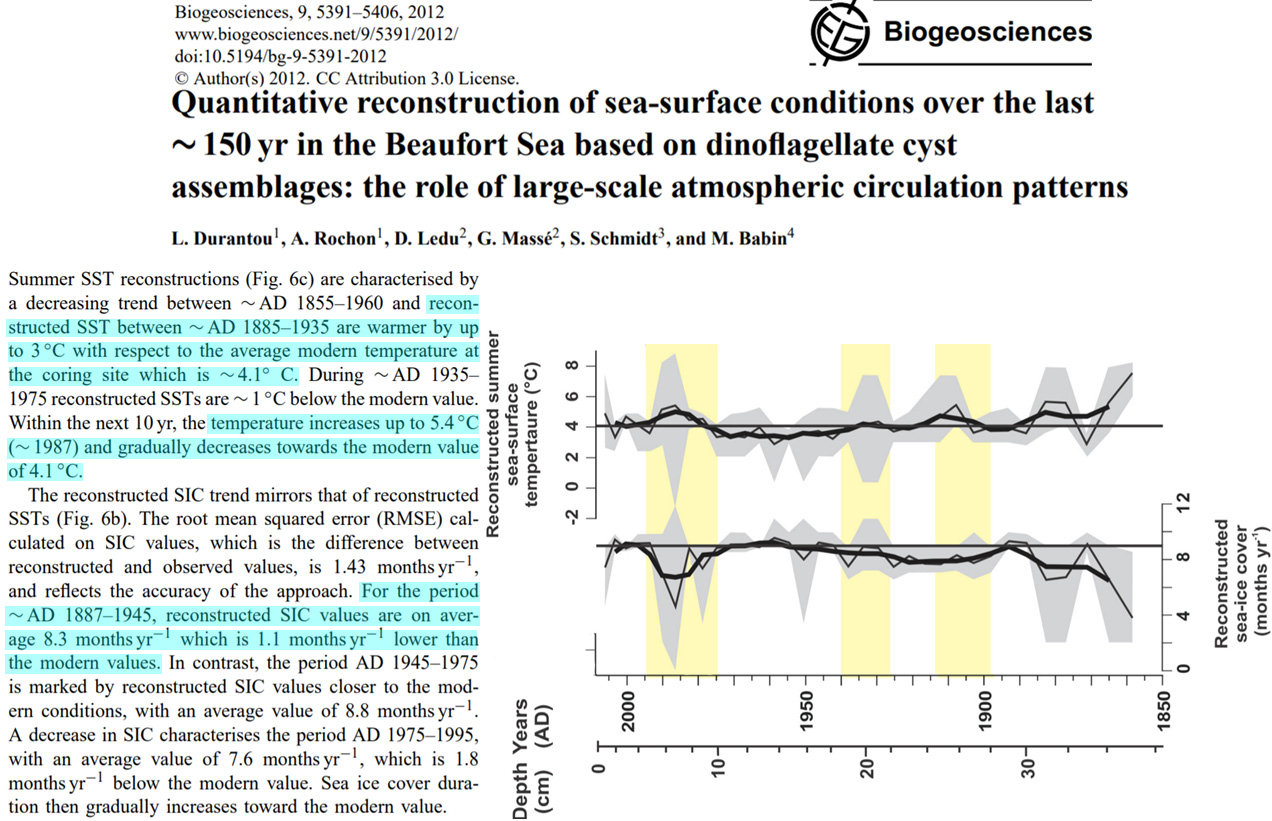The perspective that polar bears are endangered by global warming because reduced sea ice limits their seal-hunting opportunities is contradicted by observations of (a) polar bears thriving (body condition) during melt season, and (b) no trends in reduced seal consumption by polar bears in the 21st century.
From the 1880s to 1940s, the Arctic’s Beaufort Sea was up to 3°C warmer than the 2000s (Durantou et al., 2012).
Consequently, during this warmer period, the region’s sea ice coverage endured over a month less (i.e., 34 fewer days of sea ice) than it does today.
Somehow the region’s polar bears managed to survive with warmer temperatures and less sea ice.

Image Source: Durantou et al., 2012
New study: No change in seal diet of Beaufort Sea polar bears (2004-2016)
A new study (Bourque et al., 2020) finds about 65% of the Beaufort Sea polar bear diet consists of ringed and bearded seals.
Trend analysis indicates this shows there is no “clear increases or decreases in proportional consumption of any prey species” from 2004 to 2016. Further, “the effect for melt season was not significant for any individual prey (p > .10)”.
In other words, polar bears were consuming no fewer seals in 2016 than they did in 2004.
The reduction in sea ice hasn’t limited polar bears’ feeding practices.
Image Source: Bourque et al., 2020
That polar bears continue to feast on seals when sea ice is less available in the late summer is not surprising to native populations. Inuit hunters have observed polar bears capturing seals on “really thin” ice (Wong et al., 2017). Thick sea ice isn’t necessary.
Image Source: Wong et al., 2017
Polar bears’ best body condition is in August-October – after sea ice breakup occurs
Polar bears’ worst body condition – when they’re at their thinnest – occurs during the months of the year when sea ice is thick: April and May.
Their best, well-fed body condition occurs during the months when sea ice is at its thinnest, or after the seasonal ice break-up occurs: August to October.
Scientists acknowledge the “increase in body condition after break-up date was somewhat unexpected” (Galicia et al., 2020).
Image Source: Galicia et al., 2020
“Consensus” science and the “emotional charging of the polar bear”
The likely reason polar bears’ seal-hunting resiliency is “unexpected” is because many scientists have assumed the popular claim that polar bear habitats are threatened by declining sea ice is accurate.
After all, that’s what the “consensus” says.
Anyone who disagrees with the declining-sea-ice-threatens-polar-bears narrative is a “denier” engaging in “denial” according to scientists like Michael E. Mann (Harvey et al., 2018).
Some scientists have been honest enough to acknowledge the “horror stories” about “extremely skinny” or “starving” bears “on the brink of extinction” are an example of the “emotional charging of the polar bear” compromising objective analysis (Sellheim, 2020).
Image Source: Sellheim, 2020
Estimates of of the size of polar bear populations can range from 19,000 to 30,000 – an enormous uncertainty range.
Of the 19 distinct polar bear populations in the Arctic, just 7 are thought to be declining. The status of the other 12 populations is either stable, increasing, or unknown.
Perhaps a little more skepticism – rather than “emotional charging” – would be recommended in polar bear ecological science.


